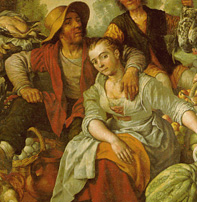The materials and fabrics used for clothing in Elizabethan reign were dictated by the English Law of the Country. These laws were called Sumptuary laws and they were made to define people according to their status and position in the society. The Colour, fabric, and material were enforced by law.
The fabrics and accessories used for clothing in the upper and middle class differed greatly from those of the lower class.
The Elizabethans were fashionable people and their clothing was elaborate and had a distinctive style statement.
Linen and wool were the chief material used for clothing in Elizabethan times.
Materials and Fabric used in Upper and Middle Class
Silk was the main fabric used for the rich. Among the other fabrics, velvet, satin, damask, and taffeta were also used exclusively for the upper class.
Silk was used to make gowns, doublets, and stockings. Silk purple doublets and clothing were worn by Earls and family members of the nobility.
Velvets were imported from Italy and were used for the outer lining of gowns and hose for men’s apparel.
Garments were further embellished with gems and pears that were sewn into the fabric. Embroideries with gold and silver and ribbon guarding were quite popular fashion trends among the nobles.
Satin was used for clothing lining as well as lining for shoes for the nobles.
Silk taffeta was used mainly for garment lining, puffs, piping, underskirts and to give volume and depth to the gowns and shirts.
Furs and laces were extravagant choices and were worn by Dukes and royalty.
Silk brocade was another common fabric in period dressing and involved intricate thread work or prints.
Ruffs were made up of linen that was stiffened with starch were worn around the neck by the nobles.
Imported cotton was widely used fabric and was used for inner lining and undergarments. Finer linen imported from France and Low Countries were used for upper class.
Wool was a common fabric and was widely used to make heavy coats, hoses, hats, brocades, and tunics.

Slashing material in Elizabethan Era
Slashing was an important trend in Renaissance fashion during the Tudor age. Slits were cut in the garment to reveal the inner slashing fabric which was pulled through to form puffs.
Materials and Fabric used in Lower Class
The Elizabethan lower class wore clothing made mainly of wool, cotton, linen, and sheepskin.
People from the lower class consisted of the commoners, peasants, servants, and beggars. They were poor and could not afford expensive fabrics and dyes. So, they used fabrics that were cheap and were easy to maintain.
Linen obtained from the flax plant was comfortable and could be laundered easily. Linen fabrics after repeated washes became soft and breathed easily. So, they were favored by the peasants and the working class of society.
Smock-frocks and chemises were made of linen. A thicker weave of linen was used for petticoats, kirtles and peasant smocks.
People used more coarse wool for heavy coats, inner clothing, pants, capes, and jerkins. Felted wool was very tough and dense and they would shrink after washing. They were quite durable and did not require any hemming.
Poorer people use rough cotton fabrics for their clothing. They also used cambric, which is a light-weight fabric and extremely durable.
Leather was used to make belts, shoes, gloves, breeches, hats, and doublets.

